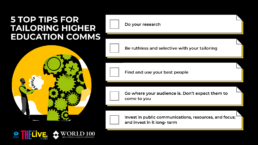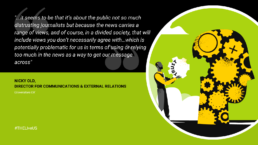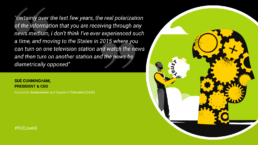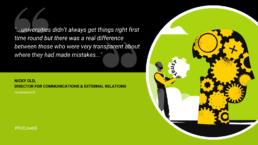Following on from our piece on the ‘Rebuilding trust in public universities’ session at THE Live US, we wanted to explore the speaker’s analysis of trust in sources of information and how that plays into the trust the public has in higher education. The session featured a panel of experts; Sue Cunningham, President and CEO of the Council for Advancement and Support of Education, and Nicky Old, Director for Communications and External Relations for Universities UK, chaired by W100 Director, Louise Simpson.
In the previous piece, we mentioned Nicky’s 5 tips for tailoring higher education communications effectively. This included ‘Go where your audience is, don’t expect them to come to you.’ Nicky elaborated on this point, suggesting that putting a press release out and going for a piece in the newspaper or on the news isn’t always going to reach people. People are spending more time on their phones and getting their information from there.

As well as being great advice, this point raised more questions on how communications teams are reaching their tailored audiences and the issue of trust arising from the source of the information. The ongoing clash is often between traditional media, such as newspapers, radio and TV, versus new media such as social media, websites, and podcasts. Getting this right is pivotal in the success of your communications but also in growing the trust of higher education overall, and each division comes with its own pros and cons.
Traditional media for many is seen as the golden goose of communications strategies, due to its historic prestige and gravitas. However, over recent years, traditional media has presented many new problems. The biggest goes back to a point mentioned by Nicky – a lot of young people are no longer watching the news or TV in general. As well as this, trust in the media has also dipped. Nicky quoted research from the Reuters Institute at University of Oxford who publish an annual report on Trust in the Media, which stated that trust in the news in the UK is amongst the lowest in the world; “in 2020 just 28% in the UK said they trust most of the news, most of the time which is down from 40% in 2019; some of this, potentially, the authors think is to do with divided societies….but it seems to be that it’s about the public not so much distrusting journalists but because the news carries a range of views, and of course, in a divided society, that will include views you don’t necessarily agree with…which is potentially problematic for us in terms of using or relying too much on the news as a way to get our message across”. Similarly, and perhaps to a greater extent, the news in the US is also a hotbed of polarization driving distrust in the medium.

Local news has also seen changes; “Local media in the UK has really suffered. I think we’ve lost about 265 local newspapers since 2005” Nicky stated. However, it is a really important source for universities and, where it is still going, universities have managed to capitalize on it. Nicky quotes examples of publications in various regions, including Bristol and East Anglia, that feature regular columns from Vice Chancellors, where they reflect on the big themes such as racism and student debt, as well as taking opportunities to directly address issues impacting local people.
But it is with new media that we are seeing real growth in public communications. As stated, people are spending more time on their phones, accessing easily digestible content on the go. Nicky stated that new platforms such as TikTok are starting to take off in the sector, alongside a range of podcasts from various institutions around the world, presenting new ways to share research and higher education messaging. However, these new opportunities with social media may not be without their own set of problems and cautions. Part of this relates to the very thing that makes it appeal to its audiences; it is quick, short and digestible and targeted at people who are time poor with short attention spans. Sue states that there is an “assumption that one can understand something fully by spending 3 seconds reading something on social media”.
She continued by questioning the reality of what is being presented; “certainly over the last few years, the real polarization of the information that you are receiving through any news medium, I don’t think I’ve ever experienced such a time, and moving to the States in 2015 where you can turn on one television station and watch the news and then turn on another station and the news be diametrically opposed”. She referenced an article she had read related to three focus groups on the COVID vaccine in the US, specifically the negative attitudes towards it; “the information that the members of the focus groups had chosen to skim from social media was for example that the vaccines were bundled together very quickly therefore how can they possibly be safe? And when presented to them, in the context of these focus groups by scientist, that the vaccines were built on technology and research over many many years, even during the period of the focus groups, their thinking began to change and their inclination to have the vaccine began to change”.

Sue also commented that she was mindful of the extent to which social media occupies hearts and minds of vice chancellors and has the potential to distort and create additional pressures, commenting that we therefore need to “support institutional leaders to position themselves in a way that understands, acknowledges, and is aware of what is going on but don’t always feel the need to respond to everything flying in through social media because some of it doesn’t deserve a response”.
The session ended on a discussion of COVID and how this period is perhaps the most important in relation to trust of universities, regarding them being part of the cure and identifying the mental health impact and how we go post-COVID.
“There have been a lot of positive and negatives. There are things we should learn and take into the future…”, said Nicky. One of the biggest things Nicky pointed out was that in these unprecedented circumstances, universities didn’t always get things right first time round but there was a real difference between those who were very transparent about where they had made mistakes, and those who were slower in communicating with audiences. In terms of a positive from the period, Nicky highlighted the increased appetite to learn about research and what academics have done during this period, and the greater interest and trust in scientists and academics.
As for Sue, the storytelling and some of the incredible stories institutions can tell relevant to COVID have been a real highlight; “The stories we can tell of the roles that universities and colleges have played both in terms of their immediate communities, in terms of education, in terms of research and the impact that has had on lives but also the impact they have had on the towns, and cities and countries in which they are working”. She finished by saying that despite the challenges of the period, there have been a number of silver linings, including the increased virtual connectivity and how we do work worldwide as a result has increased the quality of the work and made people more equal, and that connection on education from around the world enriches how we do what we do.

The World 100-led discussion at THE Live USA is available on demand to those who registered for the event. We will also be hosting a session at this month’s THE Innovation and Impact Summit (19-22 April) on how universities are using evidence of their impact to build global reputation. We will have speakers from W100 members McMaster University and The University of Manchester, and from the University of Auckland which has topped the THE Impact Rankings for the past two years

